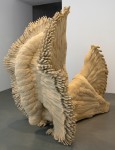UCLA Hammer Museum’s most recent exhibit may appear like an abstract, amorphous shape or some unknown alien creature. But this sculpture is more human than one may think. In fact, it is human.
Katie Grinnan, a UCLA alumna, has created a sculpture that elucidates the beauty of the human form and its extension into temporal space. The sculpture “Mirage,” made from sand, plastic and enamel, uses multiple casts of Grinnan’s body in a series of hatha yoga poses performing a sun salutation.
Time and the relationship between photography and sculpture are the principal inspirations for Grinnan’s sculpture. Grinnan said “Mirage” contrasts the concept of time that humans perceive – from one moment to the next – with theories of quantum physics, which state that all possible moments in time exist simultaneously.
The motivation for such work began early in Grinnan’s art career, when Grinnan was an undergraduate painting student at Carnegie Mellon University. During her studies, she also attended a nine-week summer residency program at the Skowhegan School of Painting and Sculpture in Maine.
After graduating, she moved to New York, where she began to explore the collision between photography and sculpture, designing installation pieces combined with photographs to create three-dimensional imagery.
Grinnan said that her purpose was primarily to create a more kinesthetic experience to photography.
“In photography, there is an inherent flatness. I’ve always wanted to put that spatial and bodily experience back into the photograph,” Grinnan said.
Grinnan pursued her master of fine arts at UCLA, where she said she began to discover the connection between photography and sculpture. She subsequently began to explore casting, a form of molding physical objects into sculptures, as a means of capturing that photography-sculpture relationship.
To make the piece, Grinnan created molds of her own body in a cycle of yoga positions and subsequently constructed sand castings out of her body molds to create the undulating figure of the sculpture. In order to do so, Grinnan had to hold each position for long periods of time. Each position, combined into one continuous figure, displays time’s subjective reality.
“There are two different types of time: linear time that you might see in stop frame animation, but then also the time in which all of those frames exist at once on the film,” said Grinnan. Similarly, with this piece, it’s sort of a compilation of multiple poses, but it’s also a solid form.”
Corrina Peipon, assistant curator at the Hammer Museum, said that Grinnan captures multiple moments in time through the succession of frozen postures of her body throughout the yoga routine.
“It has this remarkable presence because it is such an unusual form. It is something that we can’t actually see in normal space and time,” Peipon said. “Objects and people exist in time and space in ways that we can’t perceive.”
Alice Koenitz, a sculptor and peer of Grinnan, said the piece’s composition also contributes to man’s contrasting perceptions of time.
“What is interesting is that it’s sand and that it’s movement. In a way, there’s an instant, but it’s arrested,” said Koenitz. “You’re not quite sure about the time. It seems to kind of fall apart at every movement.”
Although time and the relationship between photography and sculpture define much of the inspiration for “Mirage,” Grinnan also said that Hindu gods and architecture serve as another driving force, with the gods symbolizing omnipresence with multiple arms or heads and the buildings emanating out from their central core.
Grinnan said the piece itself also conveys an image of a multi-armed deity with each molded form of her body combined together.
However, creating an actual representation of such vastly different concepts as art and quantum physics is no small task, said Grinnan. Despite the uncertainty in taking such a substantial project in the beginning, Grinnan said the fear of “not knowing” has provided her with more motivation.
“With casting, there is a commitment to make a thing when it takes up so much space. You have to trust yourself enough to start. It’s inherent that you will fail, but then the work becomes something more,” Grinnan said. “That’s the motivation to make a photograph dimensional.”
